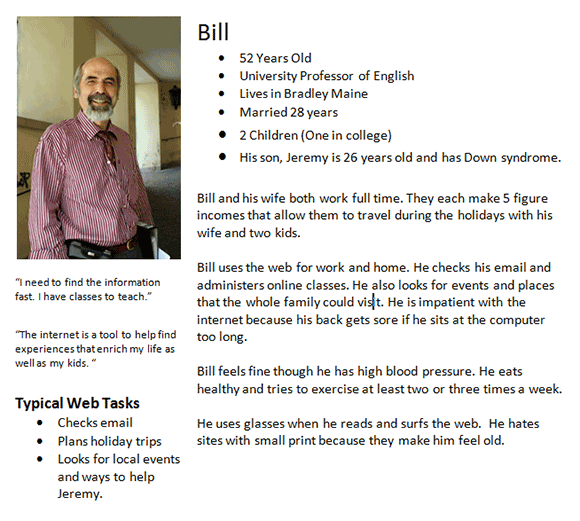What is a user persona?
A user persona is a fictionalized person who represents a large portion of your audience. A persona can have a name, a photograph, personality traits, values and more.
A user persona is not a site persona
Don’t confuse a user persona with a site persona. The site persona deals specifically with an image your website is trying to convey. A user persona on the other hand deals specifically with your target audience.
Why is a user persona useful?
A user persona makes it easier for you to connect with, and understand your target audience. It puts a face to the statistics.
Gather information about your primary audience
The first thing you need to do is collect information. It can go out and do interviews, or simply just imagine them and jot down notes. Either way, here are some of the things you should consider as you collect information.
Demographics
Collect basic demographic information to start getting a picture of your persona. You demographic information should answer the following information.
- How old are they?
- Are they male or female?
- How much do they make?
- Where do they live?
How experienced are they?
Are you targeting people who are professionals or beginners? Their skill level will affect your content. For example, if you’re creating a website for PHP programmers, you will probably be targeting an intermediate to advanced level, as opposed to targeting people learning HTML.
How technologically inclined are they?
How often does your audience use a computer, and more importantly, the internet? A 60 year old woman uses the internet differently than a 20 year old man. You need to keep this in mind as your designing your website. If they aren’t very technolocially inclined, simplicity is going to be even more important.
How will they be feeling when they visit your site?
Users may be feeling emotional as they use it. For example, let’s say a high school athlete has to undergo surgery on his knee and he wants to learn about the procedure. He is going to feel nervous about the operation and wonder if he will ever play football again. Your site will have to be reassuring and comforting to him.
How are they using your site, and where?
Will the user use your site for research or to socialize with friends? Will they be doing this from home or at work or a combination of the two?
If they’re using your site from work, they’re going to be more impatient than they would at home.
On the other-hand, if they’re at home they will be using it more for pleasure and you will need to be more creative to keep their attention.
Compile that information into a persona
Now take all the information that you’ve compiled and give it an identity. Be sure to write in the first person, it will help to give persona an identity.
Next give your persona a name and a photo, without those it’s simply a personality profile.
Below is one of the personas that I use. It was greatly influenced by the wonderful book Letting Go of The Words by Janice Redish (See bottom)

The persona above makes it easy to access all this information and really gives the sense that this is a real person. The photo is important because it’s easier to remember all this information when you can associate it with an image.
Create scenarios to drive your decisions
What are your user’s primary tasks?
People come to your site for a reason, they want to get something done or learn something. It ‘s your job to find those primary tasks and design accordingly.
In the example above Bill was created for a website that provided information for people who care for adults with mental disabilities. What kinds of tasks would Bill have?
- Look for information about this site can help them.
- Look for other adults in the area who also care for adults with disabilities
There are probably more but these are the two major tasks.
Write in the first person
Now that you’ve identified the tasks rewrite them as if they were saying it. So in this example you could write something like this.
- Are you a local business? If so, what options do you offer?
- Who else takes care of kids with Down syndrome in the area?
Everything on your site should fulfill those tasks
With the scenarios in place you should use these to drive you decisions on your website.
So in the Bill example you might have two links in a very visible spot saying,
- Caring for someone with a disability? Learn how we can help.
- Connect with other people in your area.
Comments